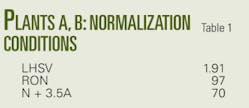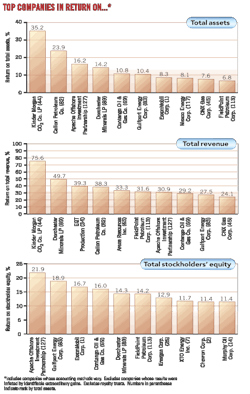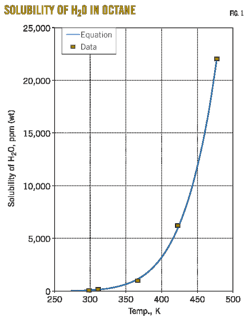Based on an article in the Saudi Aramco Journal of Technology, Winter 2009.
A normalization model for monitoring the catalyst activity for the semiregenerative naphtha reformer has been developed and employed in a Middle East refinery. This article presents that development and examples of its applications.
Daily monitoring of the semiregenerative naphtha reforming catalyst activity can enable problems to be spotted quickly and thus ensure smooth operation of the naphtha reformer. Developing a normalization spreadsheet model, therefore, allows the refinery to monitor the reforming catalyst activity on site.
With its high octane number, reformate is an important component in the gasoline pool. Knowing the reformate yield is crucial for planning gasoline production. Development in house of a spreadsheet model accurately to predict reformate yield can facilitate planning of gasoline production.
Normalization
The activity of semiregenerative naphtha reforming catalyst is typically represented by a reactor's weighted average inlet temperature (WAIT). Because during operation the semiregenerative naphtha reforming catalyst could be deactivated by poisons and coking, the required WAIT to achieve the same operating objectives should be higher as days on stream increase, meaning positive deactivation rate, although the actual WAIT in operation can fluctuate, depending on operating severities.
Evaluating the real catalyst performance requires normalization of the semiregenerative catalyst activity.
The required WAIT to achieve a fixed operating goal mainly depends on feed liquid hourly space velocity (LHSV), reformate research octane number (RON), and feed property of N + 3.5A. The effect of WAIT as a function of LHSV, reformate RON, and feed property of N + 3.5A are obtained from experimental data.
We found that a second-order polynomial equation can provide a good fit for the numerical effects on WAIT from LHSV, reformate RON, and feed property of N + 3.5A, respectively.
To compare catalyst activity based on the fixed operating parameters, we normalized the actual WAIT to the base conditions shown in Tables 1 and 2.
WAIT comparisons
We used actual operating data in normalizing catalyst activity. Figs. 1-3 compare actual WAIT and normalized WAIT for Plants A, B, and C.
In Fig. 1, the normalized WAIT always shows a positive deactivation rate, while the slope of the actual WAIT is sometimes negative. The actual WAIT requirement decreases from Day 100 to Day 150, due to an increase of feed properties (N + 3.5A) and the decrease of reformate octane requirement. These two criteria result in a lower requirement of WAIT.
Therefore, the normalized WAIT is a better indicator of catalyst performance compared to the actual WAIT. When normalized WAIT reaches the maximum temperature of 980° F., it is time to regenerate or replace the catalyst.
The actual WAIT matches quite well with the normalized WAIT from the start of the run to Day 170 (Fig. 2). During this period, LHSV, reformate octane, and feed property are relatively steady. After Day 170, the LHSV is reduced and the reformate octane is lowered in order to achieve the target cycle life. The actual WAIT requirement is lower as a result, although the normalized WAIT continues to increase and reveals the real catalyst performance.
In Fig. 3, the actual WAIT increases linearly as days on stream increase, while the normalized WAIT shows three distinctly positive slopes from Day 1 to Day 70, Day 70 to Day 140, and Day 140 to Day 240, respectively. As shown, the slope (deactivation rate) from Day 1 to Day 70 is low; from Day 70 to Day 140, high; and from Day 140 to Day 240, low again.
The normalized WAIT reveals the real catalyst performance history, but the actual WAIT cannot. The catalyst performs well from Day 1 to Day 70, whereas the catalyst is deactivated severely from Day 70 to Day 140, due to heavy, high-boiling-point material contaminated in the feed.
From Day 140 onward, we reduced the feed end point and the adjusted the operating severity, mainly RON and feed rate, lower, resulting in a lower deactivation rate. In general, the normalized WAIT can more accurately reflect the activity of the semiregenerative naphtha reforming catalyst than the actual WAIT, which varies with operating conditions.
The slope of the normalized WAIT vs. days on stream is the deactivation rate. Based on the maximum WAIT allowed and the deactivation rate, the catalyst replacement date or regeneration rate can therefore be determined.
This normalization model can also be applied to obtain the required WAIT to achieve new operating variables, i.e., feed properties (N + 3.5A), LHSV, and RON. Normalizing the operating data to a new set of operating variables can yield the required WAIT. Consequently, this normalization model could help decrease the amount of off-spec products and extend the catalyst life by avoiding unnecessarily high temperatures.
Reformate yield prediction
Reformate yield depends on reactor pressure, feed property of N + 2A, feed D86 50% boiling point, and reformate RON. The effect on reformate yield vs. reformate RON, feed property of N + 2A, reactor pressure, and feed 50% boiling point is obtained from experimental data.
Table 3 summarizes the dependent variable and independent variables for each correlation equation. It was found that the equation in the accompanying box fits the experimental data quite well.
The reformate yield is predicted by correcting for effect of the four factors named previously between the operating data and a set of projected data provided by the catalyst vendor. Table 4 shows the base reformate yield and operating conditions for yield prediction.
Predicted vs. actual yield
Figs. 4 and 5 show the comparison of the actual and predicted reformate yields vs. days on stream for Plants A and B, respectively. As shown in Fig. 4, the actual reformate yields reach 85% or 86% around Day 105. These yields are erroneous because the feed properties, product RON, and reactor pressure do not change much during those days, and the reformate yield should not increase from the high 70s to 85% to 86%.
The only significant change is that feed N + 2A increases from 42% to 57%, but this difference could not account for the increase of reformate yield from the high 70s to 86%. The refinery has confirmed that these high reformate yields are inaccurate.
The predicted yield matches the actual yield quite well, except the region of inaccurately high reformate yield. The actual reformate yield matches quite well with the predicted yield for Plant B Fig. 5.
Application
As seen in Figs. 1 to 3, the normalized WAIT can more accurately reflect the activity of the semiregenerative naphtha reforming catalyst than the actual WAIT. This normalization model can be used to monitor semiregenerative naphtha reforming catalyst performance and plan for catalyst regeneration or replacement.
The normalization model can also be applied to obtain the required WAIT to achieve new operating variables. The developed reformate yield prediction model simulates the actual reformate yield quite well (Figs. 4 and 5) and can be used to project reformate and gasoline production.
The refinery is currently using this developed spreadsheet model for monitoring semiregenerative naphtha reforming catalyst activity and predicting reformate yield.
Acknowledgments
The authors thank Saudi Aramco management for its support and permission to present the information contained in this article.
The authors
More Oil & Gas Journal Current Issue Articles
More Oil & Gas Journal Archives Issue Articles
View Oil and Gas Articles on PennEnergy.com










